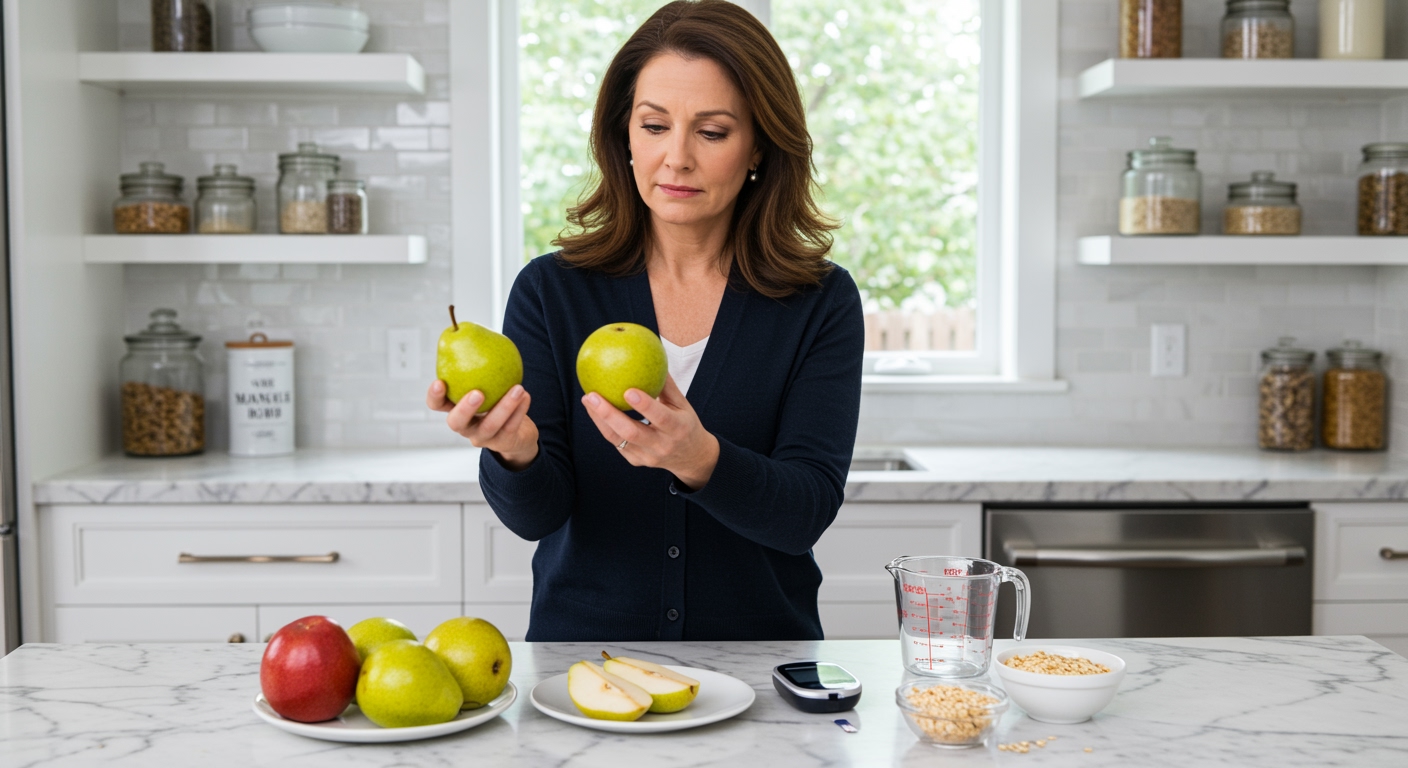✪ Key Takeaway: Pears are generally safe for diabetes when eaten in moderation due to their fiber content and moderate glycemic index.
Introduction
You reach for a juicy pear at the grocery store, then suddenly stop and wonder if this sweet fruit will send your blood sugar through the roof.
This concern makes perfect sense because managing diabetes means constantly thinking about how every food choice affects your glucose levels.
Hi, I’m Abdur, your nutrition coach and today I’m going to explain exactly how pears affect blood sugar and whether you can safely include them in your diabetes management plan.
What Makes Pears Different From Other Fruits?
Pears contain a unique combination of natural sugars and soluble fiber that sets them apart from many other fruits.
A medium pear provides about 25 grams of carbohydrates, but it also delivers 6 grams of dietary fiber.
This fiber content is crucial because it slows down how quickly your body absorbs the fruit’s natural sugars.
The glycemic index of pears ranges from 33 to 42, which places them in the low to moderate category.
Foods with lower glycemic index values cause a slower, more gradual rise in blood glucose compared to high-glycemic foods.
Pears also contain pectin, a type of soluble fiber that forms a gel-like substance in your digestive system.
This pectin helps regulate the absorption of glucose into your bloodstream, preventing sharp spikes in blood sugar levels.
✪ Fact: One medium pear contains more fiber than a slice of whole wheat bread.
How Do Pears Affect Blood Sugar Levels?
When you eat a pear, your body breaks down its natural sugars including fructose, glucose, and sucrose.
However, the high fiber content in pears creates a protective barrier that slows this breakdown process.
Research shows that eating whole pears produces a more moderate blood sugar response compared to drinking pear juice or eating processed pear products.
The skin of the pear contains the highest concentration of fiber, so eating the whole fruit with its skin intact provides maximum blood sugar benefits.
Studies indicate that people with diabetes who consume whole fruits like pears experience better long-term glucose control than those who avoid fruit entirely.
The antioxidants in pears, particularly flavonoids, may also help improve insulin sensitivity over time.
This means your cells become more responsive to insulin, which helps maintain stable blood sugar levels throughout the day.
✪ Pro Tip: Always eat pears with their skin on to maximize fiber intake and blood sugar benefits.
What Is The Best Way To Include Pears In A Diabetic Diet?
Portion control remains the most important factor when including pears in your diabetes management plan.
One medium pear (about 180 grams) represents an appropriate serving size for most people with diabetes.
Eating pears as part of a balanced meal rather than alone can further help stabilize blood sugar levels.
Combining pears with protein sources like nuts, cheese, or Greek yogurt slows down sugar absorption even more.
The timing of when you eat pears also matters for blood sugar management.
Consuming pears earlier in the day when your metabolism is more active can help your body process the natural sugars more efficiently.
Choose fresh, whole pears over canned varieties that often contain added sugars or syrups that can spike blood glucose levels.
✪ Note: Pairing pears with protein or healthy fats can reduce their impact on blood sugar by up to 30%.
Are There Any Risks Or Precautions To Consider?
While pears are generally safe for people with diabetes, certain situations require extra caution.
If you take insulin or blood sugar-lowering medications, you should monitor your glucose levels more closely when adding pears to your diet.
Some people experience digestive discomfort when eating large amounts of pears due to their high fiber content.
Start with smaller portions and gradually increase your intake to allow your digestive system to adjust.
Overripe pears contain higher concentrations of simple sugars and may cause more significant blood sugar spikes than firm, ripe pears.
Always choose pears that are firm to the touch with minimal soft spots for optimal blood sugar control.
People with gastroparesis, a diabetes complication that affects stomach emptying, should consult their healthcare provider before increasing fiber intake from fruits like pears.
✪ Pro Tip: Test your blood sugar 2 hours after eating pears to understand your individual response.
The Bottom Line
Pears can be a valuable addition to a diabetes-friendly diet when consumed mindfully and in appropriate portions.
The key to managing diabetes is not avoiding all sweet foods, but learning to choose the right ones in the right amounts.
I would love to hear about your experiences with including pears in your diabetes management plan, so please share your thoughts, questions, or feedback in the comments section below.
References
At NutritionCrown, we use quality and credible sources to ensure our content is accurate and trustworthy. Below are the sources referenced in creating this article:
- Consensus: Pears and Diabetes: Benefits, Risks, and Nutrition
- Signos: Pear Glycemic Index
- Medical Xpress: Pears Healthy Diet Diabetes
- Cleveland Clinic: Benefits of Pears
- January AI: Glycemic Index Pear





